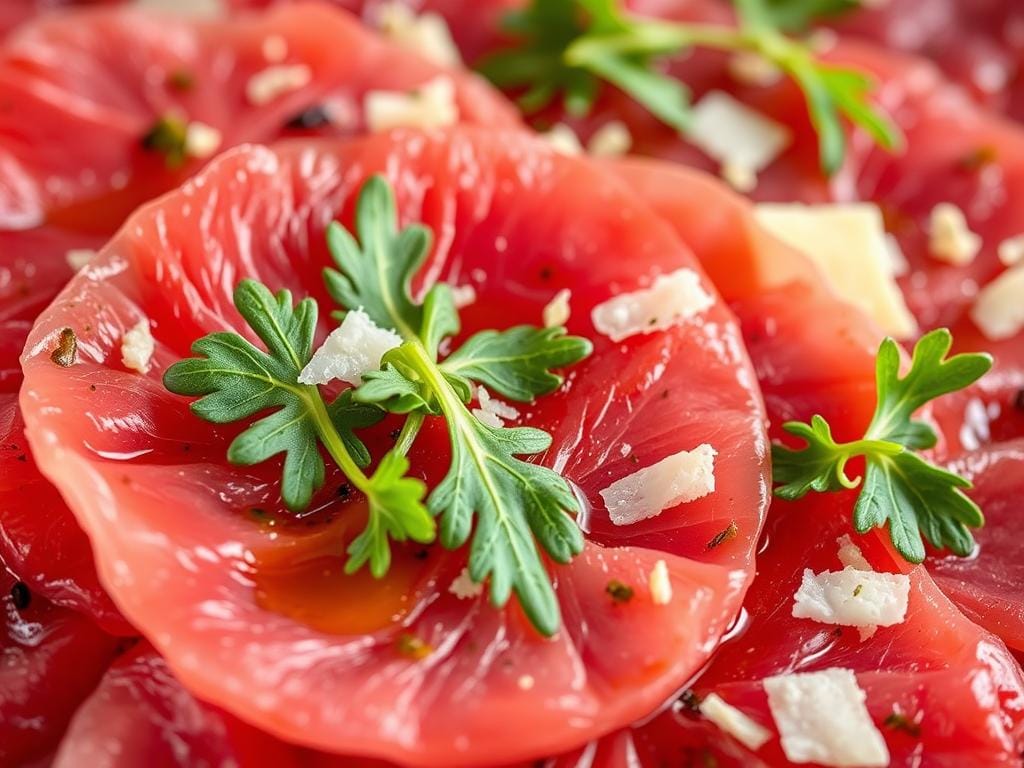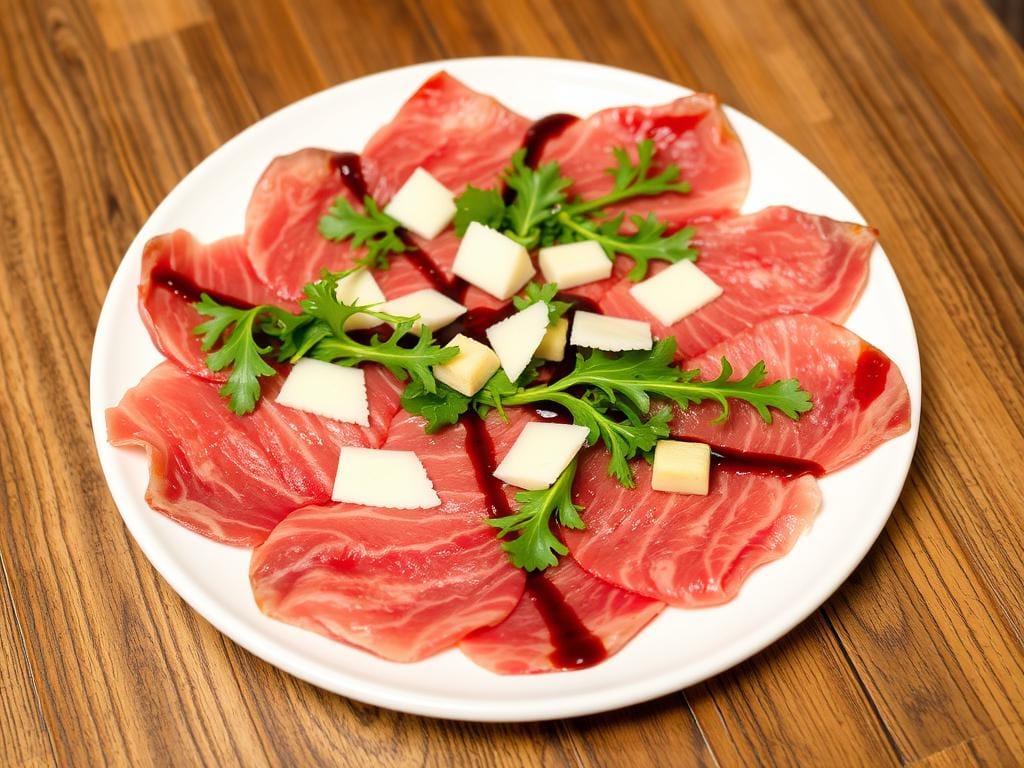I love food, and carpaccio always caught my eye. But what does carpaccio taste like? It’s raw, thin slices of meat or fish, dressed and served elegantly. I first tried it in Venice, and it was amazing.
In Harry’s Bar, where carpaccio was born, I was amazed. The Bresaola carpaccio was stunning. It was like butter, with deep colors and a rich taste.
Exploring carpaccio, I found many flavors and textures. There’s beef, seafood, tuna, and mushroom carpaccio. Each one is special, catering to different tastes.
Table of contents
- Key Takeaways
- Understanding Carpaccio: An Overview
- Flavor Profile of Carpaccio
- The Texture of Carpaccio
- Different Types of Carpaccio
- How to Enjoy Carpaccio
- Popular Restaurants Serving Carpaccio
- Health Benefits of Carpaccio
- Common Misconceptions about Carpaccio
- Tips for Making Carpaccio at Home
- FAQ about What does carpaccio taste like?
Key Takeaways
- Carpaccio is an iconic Italian dish featuring thinly sliced raw meat or fish, often served as an appetizer.
- The dish originated in the 1950s at Harry’s Bar in Venice, Italy, and was inspired by the vibrant colors of Vittore Carpaccio’s paintings.
- Carpaccio can be made with a variety of proteins, including beef, seafood, and even vegetables, each with unique flavors and textures.
- The quality and freshness of ingredients are key to a great carpaccio. The slicing must be thin and delicate.
- Carpaccio can be enjoyed alone or with flavors like greens, Parmesan, and dressings.
Understanding Carpaccio: An Overview
Carpaccio is a dish that has intrigued food lovers for decades. With its elegant presentation and delicate flavors, it’s a true celebration of high-quality ingredients. But what does carpaccio actually taste like? Whether it’s beef, seafood, or even vegetables, each type offers its own unique experience. Let’s dive into the world of carpaccio and explore its flavors, textures, and history.
For a classic recipe, check out this best Wagyu beef carpaccio recipe to try at home.
What is Carpaccio?
The name “carpaccio” comes from Venetian painter Vittore Carpaccio. His style of painting inspired the dish’s thin slices. Traditionally, it’s made from high-quality beef or fish, sliced very thinly to highlight their natural flavors and textures.
A Brief History of Carpaccio
Carpaccio was first made in 1963 by Giuseppe Cipriani at Harry’s Bar in Venice. It was for a countess who needed to eat raw meat for health reasons. The dish became popular quickly and is now a favorite in Italian and international cuisine. It’s also been adapted with different seafood and vegetables.
Common Ingredients in Carpaccio
- High-quality beef or fish (such as tuna, salmon, or sea bass)
- Extra virgin olive oil
- Lemon juice
- Arugula or other leafy greens
- Parmesan cheese
- Salt and pepper to taste
The secret to a great carpaccio is using the freshest ingredients. It lets you enjoy the natural flavors and textures of the raw meat or fish.
Flavor Profile of Carpaccio
Delicate and refined, carpaccio highlights umami and savory flavors, with its taste largely dependent on the freshness and quality of ingredients like raw beef, fish, or vegetables. The thinly sliced preparation enhances its subtle flavor, offering a unique culinary experience often described when asking, “What does carpaccio taste like?”
The dressing and garnishes add depth and complexity. This makes the dish more interesting.
Umami and Savory Notes
The umami flavor in carpaccio comes from the natural proteins and amino acids in the raw meat or seafood. This gives a savory, almost meaty taste. Ingredients like Parmesan cheese, anchovies, or soy sauce enhance this umami flavor.
This mix of umami-rich elements creates a harmonious flavor experience. It’s satisfying to the taste buds.
The umami in carpaccio is enhanced by toppings like Parmesan, capers, and olive oil. To explore more umami-rich dishes, try this easy Jezebel chicken crockpot recipe for a heartier option.
Freshness and Quality of Ingredients
The freshness and quality of the main ingredient are key to carpaccio’s flavor. When the meat or fish is extremely fresh, it tastes clean and pure. This lets the natural flavors shine.
Using inferior or old ingredients can make the dish taste unpleasant. It can have a gamey or fishy taste that ruins the experience.
Comparisons to Other Dishes
Carpaccio is similar to other raw meat or fish dishes like sashimi or beef tartare. But, its unique preparation method sets it apart. The paper-thin slicing and preparation give it a distinct texture and flavor.
While these dishes share similarities, carpaccio is unique. It has a delicate, almost translucent appearance. The flavors and textures work well together on the palate.
| Dish | Texture | Flavor Profile | Preparation Method |
|---|---|---|---|
| Carpaccio | Paper-thin slices | Delicate, umami-rich | Thinly sliced, minimally processed |
| Sashimi | Thick, chunky slices | Clean, fresh, subtle | Thinly sliced, raw |
| Beef Tartare | Coarsely chopped | Robust, beefy, seasoned | Chopped, mixed with condiments |
The Texture of Carpaccio
The hallmark of carpaccio is its delicate, paper-thin texture. It melts effortlessly in your mouth. This unique mouthfeel comes from slicing the main ingredient, often thinly sliced beef or raw fish.
For beef carpaccio, the meat is partially frozen. This makes it easy to cut into thin slices. The result is a delicate, almost translucent appearance.
The texture of carpaccio can change based on the protein used and any extra ingredients. For example, fish carpaccio is more delicate and tender than beef. The quality of the ingredients and the chef’s skill in slicing are key to getting the perfect texture.
Proper preparation is also important. Chilling the dish before serving helps keep the texture right. The mix of thinly sliced meat or seafood, fresh flavors, and good preparation makes carpaccio unique and enjoyable.

Different Types of Carpaccio
Beef carpaccio is a favorite, but now there’s more. Seafood and vegetable options have joined the mix. This makes carpaccio a fun dish for chefs and home cooks to play with.
Traditional Beef Carpaccio
Beef carpaccio started in 1950 at Harry’s Bar in Venice. It’s made from raw beef tenderloin or filet mignon. It’s dressed with olive oil, lemon, and sometimes Parmesan or arugula.
Seafood Carpaccio Varieties
- Salmon carpaccio: Fresh, raw salmon, seasoned with citrus, herbs, and olive oil.
- Tuna carpaccio: Thinly sliced sashimi-grade tuna, dressed with a light vinaigrette.
- Sea bass carpaccio: Thin white fish, served with garnishes like microgreens and citrus.
Varieties like salmon and tuna carpaccio are increasingly popular. Their lighter flavor pairs well with citrus dressings. For those interested in creative protein-based dishes, explore delicious leftover smoked chicken recipes as a unique twist.
Vegetable Carpaccio Options
- Beet Carpaccio: Thinly sliced beets paired with a tangy dressing and crunchy nuts for texture.
- Zucchini Carpaccio: Delicate zucchini ribbons lightly dressed with fresh herbs and a sprinkle of Parmesan.
- Radish Carpaccio: Crisp radish slices served with a mild vinaigrette and a touch of sea salt for balance.
These vegetable carpaccio options not only bring vibrant colors to the table but also offer fresh, light flavors. They are perfect for vegetarians and make an elegant addition to any meal.
Each type of carpaccio delivers a distinct taste and texture so answering the question, “What does carpaccio taste like?” With diverse options like beef, seafood, or vegetables, there’s truly something to satisfy every palate.
Vegetable options like beet or zucchini carpaccio are ideal for vegetarians but the vibrant colors and fresh flavors make them a beautiful addition to any table. For inspiration on vegetable preparation, see this easy slow cooker cabbage recipe.
How to Enjoy Carpaccio
Carpaccio is a famous Italian dish made from thinly sliced raw meat or fish. It’s a true delicacy when done right. Here are some expert tips to enjoy it fully:
Pairing Wines with Carpaccio
For carpaccio, choose crisp, light-bodied white wines. Vermentino or Pinot Grigio are great choices. They have bright, lemony flavors that match the dish’s delicate taste.
The acidity in these wines cleanses your palate. This lets you enjoy the carpaccio’s rich flavors even more.
Best Side Dishes to Complement Carpaccio
To truly enhance the carpaccio experience, consider pairing it with the following:
- A simple green salad dressed with olive oil and lemon juice, which adds a refreshing touch.
- Crusty bread, such as a baguette, to soak up the flavorful juices.
- Lemon wedges for an extra burst of acidity, balancing the dish beautifully.
Moreover, these light and complementary sides not only highlight the delicate flavors of carpaccio but also create a well-rounded dining experience. For further inspiration, you can explore quick dinner ideas for two, which often include simple yet effective accompaniments.
Simple sides like crusty bread or a green salad enhance the carpaccio experience. For ideas on easy accompaniments, check out these quick dinner ideas for 2 for inspiration.
Serving Temperature and Presentation
When serving carpaccio, it is important to keep it chilled to preserve its delicate flavors. Additionally, arranging it elegantly on a plate can elevate its appeal. For instance, you can top the thin slices with fresh arugula, shaved Parmesan, and capers, which add both flavor and visual interest.
Furthermore, the presentation should emphasize the vibrant, thin slices, keeping the overall look elegant and simple.
By pairing carpaccio with the right sides, wines, and thoughtful presentation, you ensure an unforgettable dining experience. As a result, this approach allows you to fully enjoy the dish’s subtle and refined qualities.
Popular Restaurants Serving Carpaccio
Carpaccio, a timeless Italian delicacy, has become a staple in top restaurants around the globe. Renowned for its ultra-thin slices of raw meat or seafood, it’s a highlight of many menus. While traditional beef carpaccio remains a favorite in iconic Italian establishments, modern chefs are elevating the dish with creative twists and innovative ingredients.
Iconic Italian Restaurants
Harry’s Bar in Venice, Italy, is famous for inventing carpaccio in 1950 by Giuseppe Cipriani. The best carpaccio restaurants in Italy focus on using fresh, high-quality ingredients. They aim to create a simple yet delicious experience.
Contemporary Takes on Carpaccio
Some modern places are trying new things with carpaccio. For example, Nobu in Shoreditch, London, offers Octopus Carpaccio. It combines Asian flavors with the classic dish.
Specialty Food Trucks and Cafés
Carpaccio is also on the menus of food trucks and cafés. This makes it easier for more people to try. Kultura in Cancun, Mexico, is one such place. They serve shrimp carpaccio with homemade tomato compote and feta cheese.

Health Benefits of Carpaccio
Carpaccio is more than just a tasty dish. It’s also good for your health. Its raw ingredients and special preparation make it a nutritious choice.
Nutritional Value of Raw Ingredients
The raw ingredients in carpaccio are key to its health benefits. Raw meat or fish keeps more of its natural nutrients than cooked food. For instance, carpaccio nutrition includes more omega-3 fatty acids. These are good for your heart and fight inflammation.
Low-Calorie and High-Protein Options
Carpaccio is great for those watching their calories. It’s a low-calorie appetizer or main dish. It’s also packed with protein, making it a nutritious choice without extra calories.
Considerations for Dietary Restrictions
While carpaccio is healthy, it’s not for everyone. Raw meat or fish can be risky for some, like pregnant women or the elderly. Always talk to a doctor before trying carpaccio, if you have health concerns.
In summary, carpaccio is a tasty and healthy dish. Knowing its carpaccio nutrition and raw meat benefits helps you enjoy it safely. Just remember to consider any dietary restrictions.
Common Misconceptions about Carpaccio
There are many myths surrounding carpaccio, with one major concern being its safety. However, when prepared correctly using fresh, high-quality ingredients, the answer to What does carpaccio taste like? is a delightful and safe culinary experience.
Is Carpaccio Safe to Eat?
Carpaccio is thinly sliced raw meat or fish. Some think it’s risky because of raw food. But, fish for carpaccio must be frozen for 24 hours at -20ºC/-4°F to kill parasites. This makes it safe to eat.
Debunking Myths About Raw Meat
Many believe all raw meat is unsafe. But, not all raw meat is risky. High-quality cuts for carpaccio are safe if handled and stored right. Knowing this helps you enjoy carpaccio safely.
Understanding Food Safety Practices
To keep carpaccio safe, follow food safety rules. This means getting meat and fish from trusted sources, keeping them at the right temperature, and preparing them correctly. By doing this, you can enjoy carpaccio’s flavors and textures safely.
Tips for Making Carpaccio at Home
Making carpaccio at home is a fun cooking journey. Focus on the main parts of this dish to get it just right.
Choosing the Right Cut of Meat
For beef carpaccio, choose sirloin or beef tenderloin, as these cuts are tender and slice thinly; for fish carpaccio, pick sushi-grade salmon, tuna, or sea bass, as they offer fresh, lively tastes that perfectly answer the question, What does carpaccio taste like?
Essential Tools for Preparation
A sharp knife or meat slicer is key for thin slices. Freezing the meat or fish helps with slicing. Use a strong cutting board and a cold plate to keep your carpaccio fresh and pretty.
Serving Suggestions and Garnishes
Place your carpaccio slices on a chilled platter. Add fresh greens, shaved Parmesan, capers, or lemon juice. Try different dressings like lemon-olive oil vinaigrette to enhance the flavors.
FAQ about What does carpaccio taste like?
Is Carpaccio Completely Raw?
Yes, carpaccio is traditionally completely raw. It consists of thinly sliced or pounded raw meat or fish, often served as an appetizer. The most common type is beef carpaccio, but it can also be made with other proteins like tuna, salmon, or veal. The dish is typically garnished with olive oil, lemon juice, capers, and shaved Parmesan, which enhance the flavor and provide balance to the raw preparation.
Why Do People Like Carpaccio?
Carpaccio is appreciated for several reasons:
- Unique Flavor
- The raw preparation preserves the pure taste of the meat or fish, often complemented by fresh, tangy, and savory toppings.
- Delicate Texture
- The thin slicing or pounding gives the meat or fish a silky, melt-in-your-mouth quality.
- Sophistication
- Carpaccio is often associated with fine dining and elegance, making it a special treat for many.
- Health Benefits
- When made from fresh, high-quality ingredients, carpaccio can be a good source of lean protein and omega-3 fatty acids (if fish is used).
- Customization
- It’s versatile and can be paired with various toppings and dressings, allowing for a personalized dining experience.
How Do You Describe Beef Carpaccio?
Beef carpaccio is a refined Italian dish, best described as:
- Appearance: Paper-thin slices of raw beef arranged in a single layer on a plate.
- Flavor Profile: Mild and slightly sweet, with a clean, fresh taste that pairs well with tangy and umami-rich toppings.
- Texture: Tender and smooth, with a melt-in-your-mouth sensation.
- Garnishes: Typically served with olive oil, lemon juice, arugula, shaved Parmesan, capers, and sometimes mustard or aioli for additional flavor.
How Do People Eat Carpaccio?
Carpaccio is eaten with a focus on its simplicity and balance of flavors. Here’s how it’s typically enjoyed:
- Using Utensils
- A fork and knife are used to cut small portions, ensuring a mix of the meat or fish with the garnishes.
- Paired with Bread or Crackers
- Often served with slices of toasted bread or crackers to add texture and make it more filling.
- Accompanied by Wine
- A light, crisp white wine or a dry rosé complements the delicate flavors of the dish.
- Sharing as an Appetizer
- Carpaccio is commonly served as a shared starter, allowing diners to sample and enjoy its elegance before the main course.

